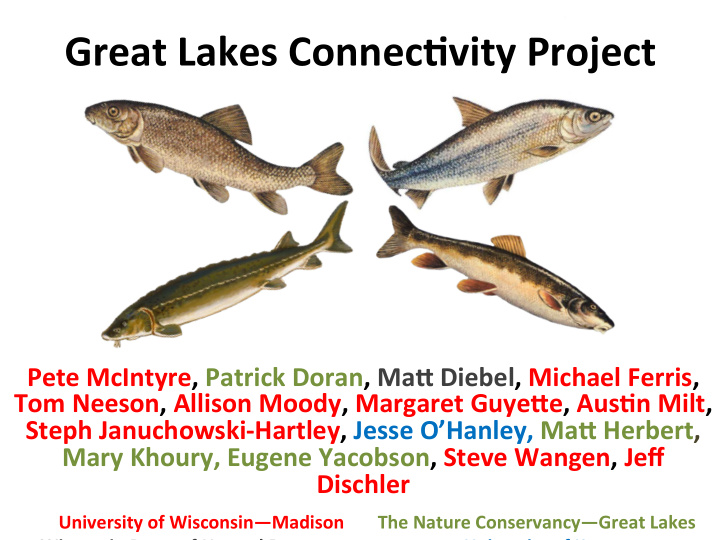



Great Lakes Connec.vity Project Pete McIntyre, Patrick Doran, Ma8 Diebel, Michael Ferris, Tom Neeson, Allison Moody, Margaret Guye8e, Aus.n Milt, Steph Januchowski-Hartley, Jesse O’Hanley, Ma8 Herbert, Mary Khoury, Eugene Yacobson, Steve Wangen, Jeff Dischler University of Wisconsin—Madison The Nature Conservancy—Great Lakes Wisconsin Dept. of Natural Resources University of Kent
GLCP Partnerships People : Dave Allan (GLEAM), Mark Holey & Jessica Barber & Stewart Cogswell (USFWS), Mark Fedora (USFS), Dale BurkeF & Pete Hrodey & Ted Treska (GLFC), Dana Infante (NFHAP, NABD), Lucinda Johnson (GLEI), Catherine Riseng (GLAHF), Sara Strassman (Am. Rivers) Funding :
Great Lakes migratory fishes • 16,900 km shoreline • >1000 watersheds • 53 fish species • 19 families • 10 exoZc spp. • 7 semelparous • 10 fall-winter migrants
Challenge #1: Migratory fish diversity
Biogeographic data for 45 migratory 3ishes
Species-speci3ic barrier analyses
Species-speci3ic barrier analyses
Challenge #2: Barrier mapping
Challenge #2: Barrier mapping 100K road crossings 4K dams Januchowski-Hartley et al. 2013 Fron%ers in Ecology & Environment
Challenge #3: QuanZfying connecZvity Cumula/ve passability: mulZply raZngs of all downstream barriers Impassible: 75% Semi-passable: 20% Fully passable: 5% Neeson et al. 2015 PNAS
Challenge #4: Porbolio opZmizaZon Budget Habitat gain 0% 0% 12% 4 0.4 0 5 6 0.8 $100,000 ??? $30,000 $80,000 $40,000 10 km 5 km 1 km 15% 0% 15% 0 0.5 2 3 $100,000 $70,000 3 km 1.5 km Porbolios address: 30% 30% - CumulaZve passability 0.3 1 - ConZngencies among removals $200,000 2 km - SoluZons are not nested by budget 100%
Challenge #5: JurisdicZonal scalability Neeson et al. 2015 PNAS
Challenge #6: LimiZng species invasions Round goby Sea lamprey NaZves can benefit even when invaders Lake sturgeon White sucker are controlled
Next Steps: invasive species 1) OpZmizaZons that compare control strategies (caps, poison, selecZve passage) 2) Explore tradeoffs between naZve and invasive species 3) Test benefits of coordinated budgeZng for barrier removal and invader control
Online decision support tool ¡ visualize barriers ¡ user-submitted edits ¡ optimization of barrier removal www.greatlakesconnectivity.org
Scenario 1 ¡ You are a project manager for the Menominee watershed. ¡ Compare the results of spending $500,000, $1 million, and $2 million on barrier removal projects.
Scenario 1
Scenario 2 ¡ In the Pentwater River, Barrier 43 is a critical barrier for sea lamprey control and cannot be removed. ¡ What are the consequences for fish passage in the watershed?
Scenario 2
Scenario 2
Next Steps: DST 1) Build species-specific opZmizaZon into DST 2) IdenZfy rules of thumb that can guide removals even without data/opZmizaZon 0.14 0.12 0.1 Passability of 0.08 recommended 0.06 barriers 0.04 0.02 0 10 20 30 40 50 60 70 80 90 100 Budget step
Data sources Loca.on Source Stream Data Coastal Data Presence Abundance Age Class Ontario MNR - ARA X X X MNR - FWIS X X X X 3 X 6 2 11 ConservaZon AuthoriZes DFO X X X X ROM X X Illinois DNR X X X X Indiana DNR X X X DEM X X Michigan DEQ X X DNR X X X X Fish Atlas X X X DNR - MRI - LP X X X DNR - MRI - UP X X X Minnesota DNR – FishMap* X X X X New York DEC X X X Ohio Ohio EPA X X X OSU X X X X Pennsylvania Fish & Boat Commission** X X X X Wisconsin DNR X X X X X FishMap X X X X US - Great Lakes USFWS Lamprey survey X X Great Lakes Goodyear Atlas X X
Recommend
More recommend